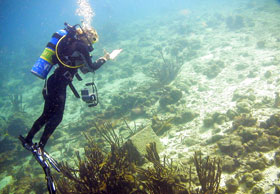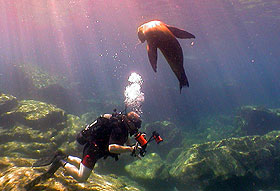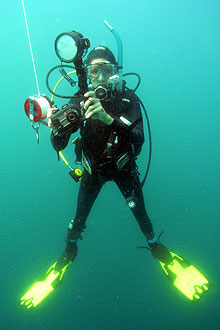  |
| HOME | THIS ISSUE | CALENDAR | GRANTS | BACK ISSUES | < BACK | NEXT > |
Safety comes first, says UConn's director of scientific diving by Karen A. Grava - December 8, 2008 | ||||||
| His job has a simple bottom line. Or rather, line to the bottom. Everyone who goes down must come up. But for Jeffrey Godfrey, director of scientific diving for UConn’s marine sciences programs in the College of Liberal Arts and Sciences, getting to the bottom and back up again requires planning, planning, and more planning. Training and more training. Testing and re-testing of equipment. And even calling the dive off when things don’t look exactly right.
Ensuring safety The dives take place in locations around the world, including Japan, Antarctica, Australia, the Caribbean, the Gulf of California, and even Long Island Sound: “Anywhere there’s water,” Godfrey says. Hazards to divers include running out of air, diving too deeply or too long for the equipment, wildlife, and especially boats, which may not heed the red and white flag that warns of divers below. The problems vary with the location of the diving. Training dives, which take place right off Avery Point, face hazards from murky water, boats, and potentially also airplanes from nearby Groton-New London Airport. “It’s easy to get separated in the water in Long Island Sound,” Godfrey says . “It’s not like diving in the Caribbean, where there’s 100 feet of visibility.” Scientific divers must be certified, and the regulations are more stringent than those for recreational divers. Certification requires 100 hours of training, one open water snorkel dive, and four deep water dives to ensure safety. Godfrey joined UConn nine years ago from the Utah State University Fish and Wildlife Cooperative Research Unit, where he was a research diver. He is current president of the American Academy of Underwater Sciences, which sets the standards for university diving programs. He teaches two courses in scientific diving, which are open to both graduate students and undergraduates, and often accompanies UConn faculty on dives. Although practice dives are often in only seven feet of water, many go deeper. One of Godfrey’s dives involved going down 240 feet to help revise the site map of the U.S.S. Monitor. The wreck of this armored turret gunboat, which sank in a storm in 1862 off Cape Hatteras in North Carolina, is now a marine sanctuary.
During another of his dives off the East Coast, a syphonophore – the world’s longest animal – swam by. Closely related to a jellyfish, the one he saw was 70 or 80 feet long, he says. A dive off Deception Island in the Antarctic revealed piles of whale bones sitting on the bottom, left over from the days of a whaling station there. Survival instinct ” For example, once at Montauk Point, Long Island, where records show the largest great white shark was caught, he watched the stripers and blues running as hard as they could instead of following their normal pattern of circling and pausing. “I just put my head down and kept working,” Godfrey says. “I wondered what was on the other end of the school, but figured it was something I didn’t need to see.” Peter Auster, associate professor of marine sciences, says he occasionally sees and interacts with dolphins, large sea turtles, sea lions, and whales underwater. “We’re down there studying the marine life,” he says, “and they are sometimes studying us.” Auster says he brings Godfrey along on expeditions that are technically challenging. “His job is to make sure that the same number of people who go underwater come back,” he says. “But he’s a scientist as well, and aids in the success of our work.” Godfrey notes that planning is critically important. “We’ve never had an incident,” he says. “It’s a hazardous environment, so we go out of the way to do training and dive planning. Our goal is to be very safe as well as efficient. And if something’s not right – the water is rough or something isn’t going according to plan – we call the dive off and come back another day.” |
| ADVANCE HOME UCONN HOME |




